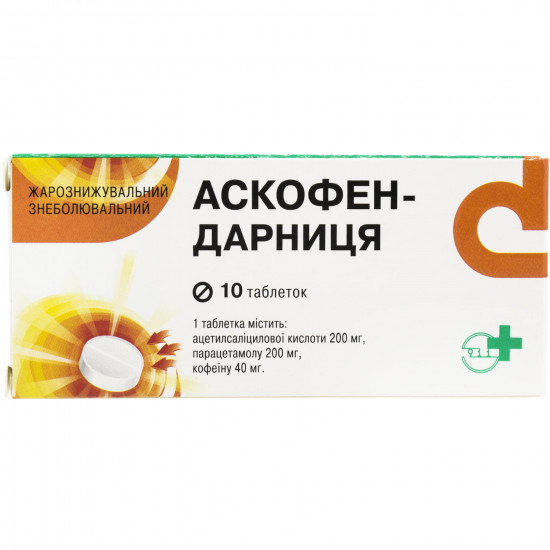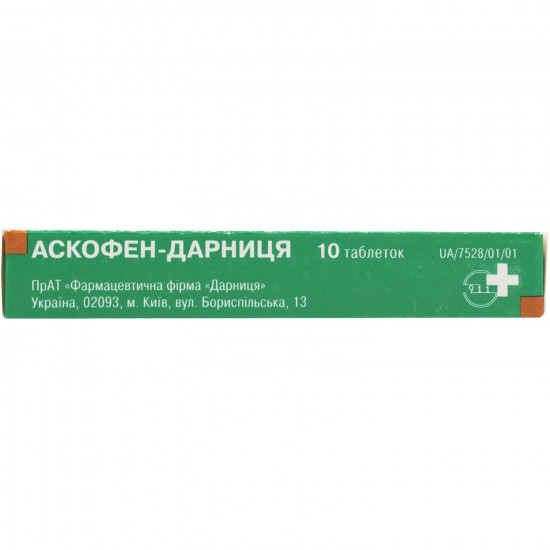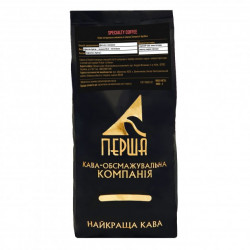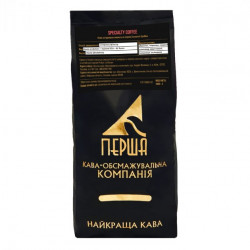



- Stock: In Stock
- Model: 182018
0% Customers recommend this product
-
5 Awesome0%
-
4 Great0%
-
3 Average0%
-
2 Bad0%
-
1 Poor0%
Reviews Over Askofen-Darnitsa of the tab. No. 10
- (0)
Total Reviews (0)
click here write review to add review for this product.
Report this review.
Description
Pharmacological properties
Drug has anesthetic, febrifugal and anti-inflammatory effect. components of medicament are synergists. the antipyretic effect of acetylsalicylic acid is implemented through central nervous system by oppression of synthesis of pgf2 prostaglandins in a hypothalamus in response to influence of endogenous pyrogens. the analgezivny effect has both peripheral, and central origin: peripheral effect — oppression of synthesis of prostaglandins of the inflamed fabrics; the central effect — influence on the centers of a hypothalamus. acetylsalicylic acid also reduces aggregation of thrombocytes. paracetamol renders analgeziruyushchy, antipyretic and very weak anti-inflammatory action that is connected with its influence on the center of thermal control in a hypothalamus and mild ability to inhibit synthesis of prostaglandins in peripheral fabrics. caffeine excites central nervous system. also strengthens positive conditioned reflexes, stimulates physical activity, reduces expressiveness of effect of somnolent and narcotic substances, strengthens effect of analgetics and antipyretics.
Indication
Therapy at poorly or moderate pain syndrome: head and a toothache, myalgia, an arthralgia, neuralgia, primary dysmenorrhea and also as febrifuge in the diseases which are followed by fever.
Use
byare Appointed by the adult on 1 tablet by 2–3 times a day after a meal. the maximum daily dose — 6 tablets (in 3 receptions). duration of treatment depends on the course and severity of a disease and should not exceed 5 days as anesthetic and 3 days — as antipyretic.
not to exceed the recommended dose.
not to accepttogether with other medicines containing paracetamol.
Contraindication
Hypersensitivity to medicament components, other derivatives of xanthine (theophylline, theobromine), other salicylates; oh, caused by intake of salicylates or others npvp, in the anamnesis; congenital hyperbilirubinemia, congenital insufficiency glyukozo-6-fosfatdegidrogenazy; blood diseases, leukopenia, anemia; acute gastrointestinal ulcers, hemorrhagic diathesis, the profound renal failure, the profound liver failure, Gilbert's syndrome, a serious cardiovascular illness, including disturbance of a rhythm, the profound atherosclerosis, a severe form of an ischemic heart disease, the profound heart failure, expressed ag; conditions of overexcitement, sleep disorder, advanced age, glaucoma, alcoholism. at use of inhibitors of Mao and also during 2 weeks after the termination of their use. a combination with a methotrexate in a dose of ≥15 mg/week
Side effects
from a cardiovascular system: tachycardia, heart consciousness, ag.
from blood and lymphatic system: anemia, a sulfatgemoglobinemiya and a methemoglobinemia (cyanosis, short wind, pain in heart), hemolytic anemia, bruises or bleedings, thrombocytopenia, an agranulocytosis. Owing to antiagregantny action on thrombocytes acetylsalicylic acid can increase risk of developing bleedings. Noted such bleedings as intraoperative hemorrhages, hematomas, bleedings from bodies of an urinogenital system, nasal bleedings, odontorrhagias, gastrointestinal bleedings and brain hemorrhages.
from nervous system: a headache, dizziness, a tremor, paresthesias, feeling of fear, concern, excitement, irritability, a sleep disorder, insomnia, alarm, the general weakness, a ring in ears.
from a GIT: a dispeptic syndrome (nausea, vomiting, discomfort and pain in epigastriums, heartburn, an abdominal pain); inflammatory diseases, erosive cankers which can cause in rare instances gastrointestinal bleedings and perforation with the corresponding laboratory and clinical manifestations.
from skin and hypodermic cellulose: an itching, rash on skin and mucous membranes (usually generalized rash, erythematic rash, a small tortoiseshell), a Quincke's disease, a multiformny exudative erythema (including Stephens's syndrome — Johnson), a toxic epidermal necrolysis (Lyell's disease).
from an endocrine system: a hypoglycemia, up to a hypoglycemic coma.
from the immune system: reactions of hypersensitivity, including an anaphylaxis, an acute anaphylaxis, rhinitis, congestion of a nose.
from a gepatobiliarny system: increase in activity of liver enzymes, as a rule, without development of jaundice, gepatonekroz (dose-dependent effect).
from respiratory organs: a bronchospasm at the patients sensitive to acetylsalicylic acid and other NPVP.
Others: bleedings can lead to acute and chronic posthemorrhagic anemia / an iron deficiency anemia (owing to the latent microbleeding) with the corresponding laboratory manifestations and clinical symptoms (asthenia, pallor of an integument, hypoperfusion, not cardiogenic fluid lungs).
Special instructionsnot to apply
with other means containing paracetamol, acetylsalicylic acid.
not to exceed the specified doses.
to use Drug with care in gastrointestinal ulcers in the anamnesis, including in a chronic or recurrent ulcer or gastrointestinal bleedings in the anamnesis, at simultaneous use of anticoagulants.
Should consult with the doctor concerning a possibility of use of medicament for patients with disturbances of functions of kidneys and a liver.
needs to be considered that at persons with alcoholic damage of a liver the risk of hepatotoxic action of paracetamol increases. Associated diseases of a liver increase risk of damage of a liver paracetamol. The danger of overdose is higher at persons with netsirrozny alcoholic diseases of a liver.
At patients with heavy infections, such as sepsis which are followed by decrease in level of glutathione at intake of paracetamol the risk of developing of a metabolic acidosis increases. Symptoms of a metabolic acidosis is the deep, speeded-up or complicated breath, nausea, vomiting, loss of appetite. It is necessary to see immediately a doctor in case of these symptoms.
At surgeries (including dental) use of the medicaments containing acetylsalicylic acid can increase the probability of emergence/strengthening of the bleeding caused by oppression of aggregation of thrombocytes for some time after use of acetylsalicylic acid.
At use of medicament the removal of uric acid can decrease. It can lead to developing of gout at patients with reduced removal of uric acid.
during treatment is not recommended to take excessive amount of drinks which contain caffeine (for example coffee, tea). It can cause sleep disorders, a tremor, feeling of tension, irritability, unpleasant feelings behind a breast because of the strengthened heartbeat.
to the Patients accepting analgetics every day in arthritis of an easy form needs to consult with the doctor.
Drug can affect results of laboratory researches on content in blood of glucose and uric acid.
during treatment should refrain from consumption of alcoholic beverages.
If symptoms do not disappear, it is necessary to see a doctor.
If the headache becomes a constant, it is necessary to see a doctor.
to Store medicament out of sight of children and out of children's reach.
Period of pregnancy and feeding by a breast. Do not apply.
Children. Drug is not used at children because of risk of development of a syndrome to Reja (a hyper pyrexia, a metabolic acidosis, disturbances from nervous system and mentality, vomiting, abnormal liver functions) at a hyperthermia against the background of viral diseases.
Ability to influence speed of response at control of vehicles or work with other mechanisms. In case of developing of dizziness it is necessary to avoid potentially dangerous occupations, such as control of vehicles and/or performance of work requiring special attention and speed of psychomotor reactions.
Interaction
Contraindicated combinations
Methotrexate — at the combined use with salicylates in a dose of ≥15 mg/week raises hematologic toxicity of a methotrexate owing to decrease in renal clearance of a methotrexate by anti-inflammatory agents and its replacement from communication with proteins of blood plasma therefore such combination is contraindicated.
MAO Inhibitors — at the combined use with caffeine perhaps dangerous increase in the ABP therefore such combination is contraindicated.
Combination which should be applied with care
Paracetamol: anticonvulsant medicaments (including Phenytoinum, barbiturates, carbamazepine), antidepressants and other stimulators of microsomal oxidation — increase products of the hydroxylated active metabolites influencing function of a liver, causing development of heavy intoxications at insignificant overdose of drug.
At simultaneous use with hepatotoxic means the toxic influence of medicaments on a liver increases. Simultaneous use of high doses of paracetamol with an isoniazid increases risk of development of a hepatotoxic syndrome.
Speed of absorption of paracetamol can increase at simultaneous use with Metoclopramidum and domperidony and decrease at use with Colestyraminum. Paracetamol reduces efficiency of diuretics. Coumarin derivatives (warfarin) at prolonged use of paracetamol increase risk of developing bleedings. Not to apply along with alcohol. Under the influence of paracetamol T ½ chloramphenicol increases by 5 times.
Kofein: Cimetidinum, hormonal contraceptives, an isoniazid strengthen effect of caffeine.
Kofein reduces effect of opioid analgetics, anxiolytics, hypnotic medicaments and sedatives, is an antagonist of the anesthetics and other medicaments oppressing central nervous system, the competitive antagonist of the medicaments oppressing central nervous system, the competitive antagonist of medicaments of adenosine, ATP. At simultaneous use of caffeine with ergotamine the absorption of ergotamine in a GIT improves, with thyritropic means — the thyroid effect increases. Caffeine reduces concentration of lithium in blood. Caffeine increases effect (improves bioavailability) analgetics-antipyretics, exponentiates effects of derivatives of xanthine, α- and β-adrenomimetik, psychogogic means.
Atsetilsalitsilov'sacid: simultaneous use with uricosuric means, such as benzobromaron, probenetsid, reduces effect of removal of uric acid (thanks to the competition of removal of uric acid renal tubules). At simultaneous use with digoxin the concentration of the last in blood plasma increases owing to decrease in renal excretion. APF inhibitors in a combination with high doses of acetylsalicylic acid cause decrease in filtration in balls owing to inhibition of vazodilatatorny prostaglandins and reduction of expressiveness of hypotensive effect.
Selection inhibitors of the return serotonin: the risk of bleeding from upper parts of a digestive tract because of a possibility of synergy effect increases. At simultaneous use with valproic acid acetylsalicylic acid forces out it from communication with proteins of blood plasma, increasing toxicity.
Drug strengthens influence of the means reducing blood clotting and aggregation of thrombocytes, side effect of corticosteroids, sulphonylurea, a methotrexate.
combination Should avoidwith barbiturates, anticonvulsants, salicylates, rifampicin, alcohol.
Overdose
paracetamol overdose Symptoms. at the adults who accepted paracetamol in a dose of ≥10 g at the children who took the medicament in a dose of 150 mg/kg of body weight the damage of a liver is possible. at patients with risk factors (long-term treatment by carbamazepine, phenobarbital, Phenytoinum, Primidonum, rifampicin, a St. John's wort or other medicines which induce liver enzymes, regular reception of excess amounts of ethanol; the glutationovy cachexia (digestive disturbances, a mucoviscidosis, HIV infection, hunger, a cachexia)) can lead reception of ≥5 g of paracetamol to damage of a liver. in the first 24 h there can be following symptoms: pallor, nausea, vomiting, anorexia, abdominal pain. damage of a liver can be shown in 12–48 h after overdose. there can be disturbances of metabolism of glucose and a metabolic acidosis. in a serious poisoning the liver failure can progress in encephalopathy, hemorrhages, a hypoglycemia, a coma and to have a lethal outcome. opn with acute necrosis of tubules it can be shown by the profound lumbar pain, a hamaturia, a proteinuria and to develop even in the absence of severe damage of a liver. noted also cardiac arrhythmia and pancreatitis.
At prolonged use of medicament in high doses from bodies of a hemopoiesis the aplastic anemia, a pancytopenia, an agranulocytosis, a neutropenia, a leukopenia, thrombocytopenia can develop. At administration of medicament in high doses from central nervous system the dizziness, psychomotor initiation and disturbance of orientation is possible; from an urinary system — nephrotoxicity (renal colic, interstitial nephrite, capillary necrosis).
emergency medical service is necessary forAt overdose. The patient should be taken immediately to hospital even if there are no early symptoms of overdose. Symptoms can be limited to nausea and vomiting or can not reflect weights of overdose or risk of defeat of bodies. It is necessary to consider treatment by activated carbon if the overdose of paracetamol was accepted within 1 h. Concentration of paracetamol has to be measured in blood plasma in ≥4 h after reception (earlier concentration are doubtful). Treatment by N-Acetylcysteinum can be performed during 24 h after intake of paracetamol, but the maximum protective effect is gained at its use during 8 h after reception.
Efficiency of antidote sharply decreases after this time. If necessary to the patient in/in enter N-Acetylcysteinum according to the established list of doses. In the absence of vomiting, methionine orally as the corresponding alternative in the remote areas out of hospital can be applied.
Symptoms of overdose of acetylsalicylic acid. The overdose by salicylates is possible because of the chronic intoxication which arose owing to long therapy (use of 100 mg/kg/days within more than 2 days can cause toxic effects) and also because of acute intoxication which poses threat for life (overdose) and which reasons can be an accidental use by children or inadvertent overdose.
Chronic poisoning with salicylates can have the hidden character as its signs nonspecific. The moderate chronic intoxication caused by salicylates or a salitsilizm, is noted, as a rule, only after repeated receptions in high doses. Main symptoms: balance disturbance, dizziness, a ring in ears, deafness, the strengthened sweating, nausea and vomiting, a headache, confusion of consciousness. The specified symptoms can be controlled a dose decline. The ring in ears is possible at concentration of salicylates in blood plasma of 150-300 mkg/ml. Serious side reactions note at concentration of salicylates in blood plasma 300 mkg/ml. The significant change of acid-base balance which can differ depending on age and weight of intoxication testifies to acute intoxication. Weight of a state cannot be defined only on the basis of concentration of salicylates in blood plasma.
caffeine overdose Symptoms. Caffeine in high doses can cause pain in epigastric area, vomiting, a diuresis, rapid breathing, premature ventricular contraction, tachycardia or cardiac arrhythmia, influence on central nervous system (dizziness, insomnia, nervous excitement, irritability, the heat of passion, uneasiness, a tremor, spasms).
Treatment. At overdose the emergency medical service is necessary even if symptoms of overdose are absent. Methionine use orally or Acetylcysteinum can cause positive effect during 48 h after overdose. It is necessary to take also all-supporting measures, symptomatic therapy, including use of antagonists of beta adrenoceptors who can eliminate cardiotoxic effects.
Storage conditions
In original packing at a temperature not above 25 °C.
Specifications
| Characteristics | |
| Active ingredients | Acetylsalicylic acid, Caffeine, Paracetamol |
| Applicant | Darnitsa |
| Code of automatic telephone exchange | N02BA51 Acetylsalicylic acid, combinations without psikholeptik |
| Interaction with food | Later |
| Light sensitivity | Not sensitive |
| Market status | The branded generic |
| Origin | Chemical |
| Prescription status | Without prescription |
| Primary packing | blister |
| Producer | DARNITSA CIAO PHARMACEUTICAL. FIRM |
| Quantity in packing | 10 tablets |
| Release form | tablets for internal use |
| Route of administration | Oral |
| Sign | Domestic |
| Storage temperature | from 5 °C to 25 °C |
| Trade name | Askofen |




















